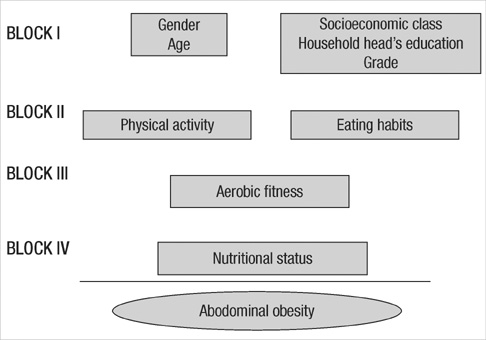J Korean Med Sci.
2011 Jan;26(1):78-84. 10.3346/jkms.2011.26.1.78.
Epidemiology of Abdominal Obesity among Adolescents from a Brazilian State Capital
- Affiliations
-
- 1Universidade Federal de Santa Catarina, Programa de Pos-Graduacao em Educacao Fisica, Florianopolis, Santa Catarina, Brazil. diegoaugustoss@yahoo.combr
- 2Instituto Federal de Educacao, Ciencia e Tecnologia do Ceara, Campus Juazeiro do Norte, Ceara, Brazil.
- KMID: 1777980
- DOI: http://doi.org/10.3346/jkms.2011.26.1.78
Abstract
- The objective of this study was to investigate the effects of socioeconomic, demographic and lifestyle factors on abdominal obesity in adolescents from a Brazilian state capital. In this cross-sectional study, 656 high school students (423 girls and 233 boys) from public schools, ranging in age from 14 to 19 yr, were evaluated. Abdominal obesity was identified based on waist circumference. Socioeconomic data (socioeconomic status, household head's education, and school grade), demographic data (gender and age), and information regarding lifestyle (physical activity, eating habits, aerobic fitness, and nutritional status) were collected. Logistic regression was used for multivariate analysis. The prevalence of abdominal obesity was 6.6% (95% confidence interval [CI]: 4.6-8.4). Being in the second (odds ratio [OR] = 0.41; 95% CI: 0.19-0.88) or third year (OR = 0.18; 95% CI: 0.06-0.59) of high school was a protective factor against abdominal obesity. In addition, students presenting low aerobic fitness (OR = 4.10; 95% CI: 1.62-10.4) and those with excess weight (OR = 208.6; 95% CI: 47.7-911.7) had a higher probability of abdominal obesity. In conclusion, demographic factors such as school grade, lifestyle habits, low aerobic fitness and excess weight are associated with central obesity.
Keyword
MeSH Terms
Figure
Reference
-
1. Gyárfás I, Keltai M, Salim Y. Effect of potentially modifiable risk factors associated with myocardial infarction in 52 countries in a case-control study based on the INTERHEART study. Orv Hetil. 2006. 147:675–686.2. Park J, Hilmers DC, Mendoza JA, Stuff JE, Liu Y, Nicklas TA. Prevalence of metabolic syndrome and obesity in adolescents aged 12 to 19 years: comparison between the United States and Korea. J Korean Med Sci. 2010. 25:75–82.3. Singh R, Bhansali A, Sialy R, Aggarwal A. Prevalence of metabolic syndrome in adolescents from a north Indian population. Diabet Med. 2007. 24:195–199.4. Taylor RW, Jones IE, Williams SM, Goulding A. Evaluation of waist circumference, waist-to-hip, and the conicity index as screening tools for high trunk fat mass, as measured by dual-energy X-ray absorptiometry, in children aged 3-19 y. Am J Clin Nutr. 2000. 72:490–495.5. Fernandes RA, Casonatto J, Christofaro DG, Cucato GG, Oliveira AR, Freitas Júnior IF. Family factors associated with abdominal obesity in adolescents. Rev Bras Saude Mater Infant. 2009. 9:451–457.6. Olinto MT, Costa JS, Kac G, Pattussi MP. Abdominal obesity epidemiology amongst adult women resident in Southern Brazil. Arch Latinoam Nutr. 2007. 57:349–356.7. World Health Organization (WHO). The Second Decade: Improving Adolescent Health and Development. 2001. Geneva: World Health Organization.8. Canadian Society for Exercise Physiology (CSEP). The Canadian Physical Activity, Fitness and Lifestyle Appraisal: CSEP's guide to health active living. 2003. 2nd ed. Ottawa: Canadian Society for Exercise Physiology.9. Cole TJ, Bellizzi MC, Flegal KM, Dietz WH. Establishing a standard definition for child overweight and obesity worldwide: international survey. BMJ. 2000. 320:1240–1243.10. Critério de Classificação Econômica Brasil. Associação Brasileira de Empresas de Pesquisa (ABEP). 2003. accessed on 10 April 2005. Available at http://www.abep.org/codigosguias/ABEP_CCEB.pdf.11. Marcus BH, Rossi JS, Selby VC, Niaura RS, Abrams DB. The stages and processes of exercise adoption and maintenance in a worksite sample. Health Psychol. 1992. 11:386–395.12. Nigg CR. There is more to stages of exercise than just exercise. Exerc Sport Sci Rev. 2005. 33:32–35.13. Rodriguez Añez CR, Reis RS, Petroski EL. Brazilian version of a lifestyle questionnaire: translation and validation for young adults. Arq Bras Cardiol. 2008. 91:92–98.14. Fernandes RA, Rosa CS, Buonani C, Oliveira AR, Freitas Júnior IF. The use of bioelectrical impedance to detect excess visceral and subcutaneous fat. J Pediatr (Rio J). 2007. 83:529–534.15. Janz KF, Dawson JD, Mahoney LT. Increases in physical fitness during childhood improve cardiovascular health during adolescence: the Muscatine Study. Int J Sports Med. 2002. 23:Suppl 1. S15–S21.16. Irving BA, Davis CK, Brock DW, Weltman JY, Swift D, Barrett EJ, Gaesser GA, Weltman A. Effect of exercise training intensity on abdominal visceral fat and body composition. Med Sci Sports Exerc. 2008. 40:1863–1872.17. Ortega FB, Ruiz JR, Sjöström M. Physical activity, overweight and central adiposity in Swedish children and adolescents: the European Youth Heart Study. Int J Behav Nutr Phys Act. 2007. 4:61.18. Kelishadi R, Razaghi EM, Gouya MM, Ardalan G, Gheiratmand R, Delavari A, Motaghian M, Ziaee V, Siadat ZD, Majdzadeh R, Heshmat R, Barekati H, Arabi MS, Heidarzadeh A, Shariatinejad K. CASPIAN Study Group. Association of physical activity and the metabolic syndrome in children and adolescents: CASPIAN Study. Horm Res. 2007. 67:46–52.19. Kim Y, Lee S. Physical activity and abdominal obesity in youth. Appl Physiol Nutr Metab. 2009. 34:571–581.20. McCarthy SN, Robson PJ, Livingstone MB, Kiely M, Flynn A, Cran GW, Gibney MJ. Associations between daily food intake and excess adiposity in Irish adults: towards the development of food-based dietary guidelines for reducing the prevalence of overweight and obesity. Int J Obes (Lond). 2006. 30:993–1002.21. Leite ML, Nicolosi A. Lifestyle correlates of anthropometric estimates of body adiposity in an Italian middle-aged and elderly population: a covariance analysis. Int J Obes (Lond). 2006. 30:926–934.
- Full Text Links
- Actions
-
Cited
- CITED
-
- Close
- Share
- Similar articles
-
- Epidemiology of the metabolic syndrome among Korean children and adolescents
- Current status and epidemiology of adult obesity in Korea
- Changes in the Prevalences of Obesity, Abdominal Obesity, and Non-Alcoholic Fatty Liver Disease among Korean Children during the COVID-19 Outbreak
- Prevalence of Metabolic Syndrome and Obesity in Adolescents Aged 12 to 19 Years: Comparison between the United States and Korea
- Adolescents' health behaviors and obesity: Does race affect this epidemic?


